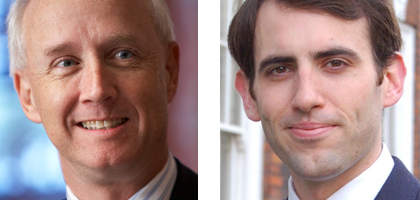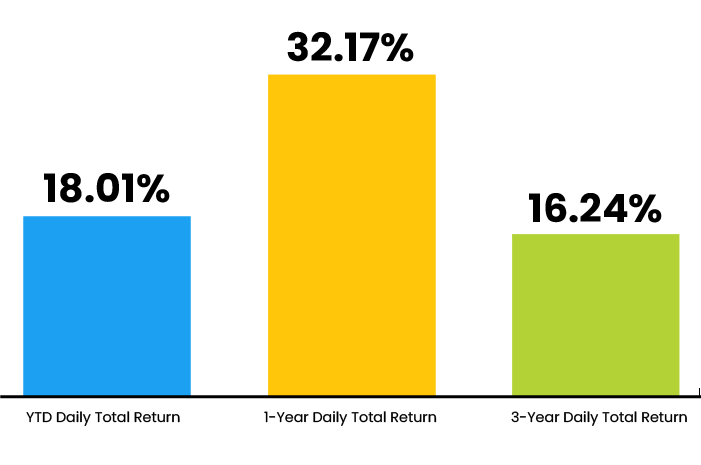Editor’s note: Older investors often look to dividend-paying investments for income. Rethinking65’s Dorothy Hinchcliff caught up with Guinness Atkinson Asset Management’s CEO Jim Atkinson and portfolio manager Dr. Ian Mortimer, CFA, to talk about the company’s active ETF focused on dividends.

Dorothy Hinchcliff: Jim and Ian, we’re here today to talk about Guinness Atkinson’s SmartETFs Dividend Builder ETF (DIVS) — its strategy, what kind of investor would be interested in this ETF, and your economic outlook. But first, I want to briefly ask you about a particular distinction the ETF has. The dividend builder ETF and the SmartETFs Asia Pacific Dividend Builder ETF started life as mutual funds. In March 2021, they became the very first mutual funds to convert to ETFs. Six months later, why does the conversion make sense, and do you still intend to convert your other mutual funds to ETFs?
Jim Atkinson: The answer is pretty simple really. Investors are voting with their feet. They prefer ETFs over mutual funds. You can see that in the industry flow data. And there are some good reasons why they prefer them: transparency, cost, tax efficiency. You want to give your customers what they want. Being the first was a little bit painful because you’re going down a trail that hasn’t been blazed before. They’re just a lot of details that had to be sorted out. And we spent a couple of years on that project, and we learned a hell of a lot along the way. We are planning on doing more conversions, potentially the whole line of funds. I just take the view that ETFs are a better mousetrap.
Hinchcliff: How has it worked out in these last six months for the two that you’ve converted so far in terms of interest, assets?
Atkinson: Assets in both are not necessarily as much as we’d like. There seems to be more interest, but these funds haven’t taken off in terms of massive inflows. But that’s what we sort of expected. These funds are gems, but I don’t think people necessarily realize how good they are.
Hinchcliff: The conversion must have been a huge project — you’re not at a massive investment house like Vanguard or Fidelity. To embark on this kind of years’ long project was pretty ambitious. Did you feel that way when you were doing it?
Atkinson: Yeah, to a degree, but I’ll tell you, this is true of a lot of things in life: You don’t fully appreciate what you’re about to do at the beginning of the endeavor, and you don’t fully appreciate how hard it’s going to be. What made this project difficult wasn’t so much that there was a single big obstacle. It was the scope of the project; there were so many details that we had to think through. The conversion touched every aspect of our operation. And it just is the number of details and the minutiae were at times overwhelming, but you know we just kept pushing it. Yeah, it might have been better if we had 100 people to throw at this project, but we didn’t, and we still got it done.
Hinchcliff: I’m glad it’s worked out. I wanted to talk a little bit about the dividend builder fund being an active, thematic ETF with its benchmark MSCI World. You focus on quality dividend growers rather than dividend history. Dividend growers don’t necessarily pay high dividends, but have a persistent high return on capital, according to your materials. I’d like you to explain what a dividend-growing company really is and why a high return on capital is important to that definition.
Ian Mortimer: It’s a great question. When we launched the strategy, we did a lot of work thinking about what is the best way to invest in dividend-paying companies. First, there’s lots of good evidence to suggest, if you focus on investing in dividend-paying companies in general as a wider group, then that is a good thing and generally speaking they outperform over the long term. As a factor, if you like, dividend payers are formed much like growth or value or whatever you might want to suggest. Within the broad group of dividend payers, you can have companies that maybe pay a flat dividend over time; that can be high or low. And generally what you find is if you pay a flat dividend, you do about the same as the market, you did not get that outperformance. If you’re a company that pays dividends, and then it is cut over a period, then you tend to underperform quite significantly. And in fact, it is the subgroup of dividend-paying companies that managed to successfully grow their dividend over time that drives the overall outperformance of the dividend payers as wide a group.
So where we wanted to start was, how can we put ourselves in the best position to identify companies that are more likely to be able to grow their dividends and not cut it, which is so crucial in the future. What we find is often people look back at how long companies paid a dividend — the dividend aristocrats — and that is helpful. But the correlation with future growth is actually relatively modest. There are plenty of examples of companies that have continued to pay their dividend, even though actually they shouldn’t have done it. Often things like payout ratios are helpful guides, but they are not foolproof. And in fact, when you go through it all, you find the fundamental metrics that really correlate highly with future dividend growth are return on capital, balance sheet strength, and often the size of the starting dividend yield. If you start with them more moderate, it’s easier to grow than if you start with a very high dividend yield.
So that is why we focus on the high return on capital over a decade. Because that gives us a group of businesses that are well placed to be able to pay and then grow that dividend over time. The reason that all that sort of fits together is that ultimately the companies that can successfully grow their dividends are really the companies that themselves can grow. So if you take your cash flows and reinvest them in profitable projects that grow your asset base, it creates further cash flows, a portion of which you can then pay out to shareholders. The rest you use to reinvest in the business, and as the business grows, so does your cash flow, so do distributions to shareholders. And that’s the sort of circular argument, if you like, why it all links together.
Hinchcliff: Active ETFs managers use specific metrics, just as you’re doing. There are passive ETFs based on dividends. But do any end up with a similar universe of companies to yours, or is that just not achievable through an index?
Mortimer: I mean ultimately it’s a qualitative measure to get to a group of companies that we believe are very high quality based on our definition and pay dividends that we believe are more than likely to be sustainable. And that’s our starting point. The next stage is to start to think about which of those companies are actually offering good value and create a portfolio that has diversification, not only just across the dividends, but also across the companies. You don’t want to come up with a portfolio in one particular industry. Clearly, if that industry changes, all the dividends get cut the same time. So I think the difference really from the active manager point of view is that we’re spending a lot of our time trying to select the best companies for the portfolio from the group of companies that we’ve already decided look like what we want.
Hinchcliff: How much are you narrowing down that group when you apply your criteria?
Mortimer: In terms of the companies that get into our investable universe, that’s approximately 500. It’s a very high hurdle rate to get into that group. In the portfolio, we only select 35 companies. It’s a very concentrated portfolio, which is very different compared to the benchmarks. The active share is extremely high; it’s typically around 90%.
Hinchcliff: We’ve talked about a lot of the criteria that you use to select that group of companies. Is there anything else that we haven’t touched on that’s particularly important to your portfolio selection and why would that be?
Mortimer: We like companies with reasonable debt levels that don’t own overly leveraged businesses, and that’s another key risk element from the dividend perspective. What type of company cuts the dividend? One that has a lot of debt. Any sort of problem that occurs, you then see the dividend is quite easily cut.
In terms of the portfolio when we’re selecting stocks, we are adding the valuation criteria — that’s really important. Ultimately, when we are thinking about the return that our investment company would make, we break that down essentially into three areas: cash flow, earnings growth with multiple expansion, and shareholder return, which is typically dividends. It could be buybacks, and then maybe within FX if you’re investing internationally.Dorothy, could be easier to read if last sentence is a separate sentence.
And what we’re trying to achieve is an element from all three parts. We’ve got these good-quality companies that are growing, so hopefully that will drive future cash-flow growth. It might be modest, but it’ll still be there. We’re looking for cheaper companies so we can attempt to achieve multiple rate growth over time as well. And then thirdly, you really want that nailed on the dividend you’re going to receive.
Hinchcliff: Are you happy with your performance relative to the benchmark that you’ve picked?

Mortimer: Absolutely. I think we’ve got a very, very strong track record. I think what’s really interesting is through the most recent period, let’s say the last five years, clearly growth in the FANG-type stocks have been what’s driven markets, which is a big part of our benchmark. And that big part of our benchmark has performed most strongly. But it is not really available to us in the sense that they typically don’t pay dividends. We only buy companies that do actually pay a dividend, and things like Facebook, etc., would not be accessible to us. And then maybe some of the others where the yield is particularly low. Our fund has done very well with that benchmark, which has been really driven by growth, despite us being more value oriented and focusing on just the dividend payers.
I think another thing is really important. Last year was a testing time for dividend strategies. You saw significant dividend cuts, particularly internationally. Across the board because of COVID and the pandemic economic sudden stop, the tide went out. Companies that had too much debt were not sustainable businesses. If you looked at the Euro stocks, for example, half the company cut their dividends. The MSCI World for dividend distribution got cut about 13% year over year. If you look at our portfolio of 35 companies, over that same period we had one company that reduced their dividend. We didn’t have any that canceled. I think 28 of our companies actually grew their dividend. We went through a period that was extraordinarily and extreme, and yet they continue to pay their dividend, which is I think a really big feather in the cap for us.
Hinchcliff: You made some good choices that kept with your strategy.
Mortimer: But if you took a high-yield approach, you’d have seen significant dividend cuts. If you’re relying only on the income from investment, if that goes away for whatever reason, that’s a really big problem. One of the things we’re really trying to do is provide that reliable income, and companies that will sustain it, regardless of what’s going on.
Hinchcliff: Your top five holdings in early October were interesting because they’re really different from each other: Novo Nordisk, Arthur J. Gallagher, Microsoft, Otis and Paychex. Can you tell me why they are a good fit for the dividend builder fund?
Mortimer: I mentioned we have 35 stocks. I’m not sure whether I did mention that they’re equally weighted. Each position is approximately 3% of our portfolio. That then does lead to, as I said, the high active share. And it also means it is very different than a market-cap-weighted approach. So when you look at our top five holdings, they are not really our best five ideas. They are really those stocks that have outperformed just a little bit so they become slightly larger than the others in the portfolio. So maybe they’re in a 3.1% position rather than in a 2.9% position.
Ultimately, we do apply a rebalancing process over time to trim some of the winners and put that money back into things that underperformed — we do the right things that we’re supposed to be doing as investors. But I think your point is a good one. We’re running a global product so we’ve got companies in many different jurisdictions and across different sectors as well. If you take the high-yield approach, you will be really pushed into certain sectors. You might have already been overweight in things like utilities or real estate or commodity companies because that’s where the high dividend yields are. But what you wouldn’t have necessarily is allocations to the IT sector. What we would say if you take a more moderate approach, you will find ideas and other areas. And actually those other areas are beneficial, because you can still get a reasonable dividend, but that dividend might grow faster and also the company itself might be in a position to actually grow faster, which again gives you the benefit from the total-return and capital-return aspects as well. I think that sort of ability to move across different sectors, and geographies is really powerful.
What all these companies have in common is they have high returns on capital, are well managed, have reasonable debt. Because they’ve got high returns on capital, they keep managing to keep at bay competition. Their margins are not getting eroded by people stepping into what they do.
Hinchcliff: You touched on this earlier in our conversation and it’s certainly mentioned in some of your materials: COVID-19 has damaged and likely will continue to damage the global economy. How are you assessing the potential impact on the companies in the dividend builder portfolio and how is it affecting your buy-sell decisions?
Mortimer: We did make some changes to the portfolio very early on. Back in February last year, as we saw what seemed to be a changing world and it could be quite serious, we did exit some positions, which we felt would be more effective. So we sold companies like Royal Dutch Shell, for example, because the oil price could be impacted from a demand perspective. And that was a pretty good call back in February 2020. We also sold called WPP, which is a global advertising business, again it was a similar thing in that advertising was likely to shrink, and it was a company that was somewhat under pressure already anyway. We don’t typically make calls based on the macro world. But this was definitely different. Dorothy, should this be one sentence?
Hinchcliff: For older investors who are more reliant on fixed income, inflation can be particularly detrimental if it’s high and lasts long enough. As you know, inflation has been running over 5% in the U.S. That’s higher than it’s been in a long time. Can you talk a little bit more about your outlook for inflation in the U.S. and elsewhere in the world and what kind of impact that could have on investments?
Mortimer: I think it’s a big question. There are sort of two broad camps. One is that high inflation is transitory. And then the second camp believes it’s actually likely to persist. At the moment, the jury is out somewhat. I don’t think either camp has particularly a definitive answer that beats the other. We are working through what the arguments are to try and figure out where we are.
In the transitory camp, we’d first of all say there’s a base effect. We started very low and inflation is coming up. That sort of differential will slowly work itself out as we get back to normal and it disappears in 2022. A classic example is hotel prices. They’re up 20% year over year. But actually, if you look at the long-term trend, you’re back to about one-and-a-half percent, because you just had a big dip and they came roaring back. If you just draw a line from before, you’re kind of back to where you were and you’d say it’s a base effect. There’s been some pent-up demand that will dissipate and actually we’ll get back to our long-term trend. That would mean the U.S. fiscal stimulus infrastructure bill will not cause inflation, because those stimulus checks were spent and investment in infrastructure should lead to productivity gains and somewhat offset any issues.
The labor-market wage inflation is another big issue. There’s a good argument to suggest it’s pretty disruptive at the moment in terms of the labor-force participation rate, for example, changing careers and various other things. And then the other thing is that inflation expectations are pretty well anchored. That would be the kind of case for inflation being transitory.
The other side that has persisted is that we can see companies passing on cost increases. Often those cost increases are stickier because it’s easier to have companies increase their cost than to bring them back down again. You can see that through the PPI versus CPI, for example. The PPI tends to not follow in terms of that increase in profitability because supply chains might be being redesigned. So, there’s more focus on resilience rather than on globalization. Those things might cause inflationary effects. And the argument I made about labor markets being on their head, with people deciding to change careers, could mean wage inflation will have to exist to try to get people back to the jobs that aren’t getting done. Also, can central banks anchor inflation expectations? Do they have enough tools? They say they do, but can they?
If you take all this in context, we are more in the transitory camp. But there’s a lot to be worked out. There are good arguments on how inflation could occur. I think it’s really a wait-and-see game, until we can get more information.
Hinchcliff: Older investors may be more sensitive to their purchasing power being eroded. Should they be becoming more concerned about inflation yet or should they take a more of a wait-and-see attitude? What would you tell them if they were to ask you that question?
Atkinson: Even low levels of inflation over a long period of time can be pernicious and damaging to your level of income. And the fact that you’re asking these questions about our predictions for inflation raises a bigger question: We don’t know what the future is going to bring. But if there is high inflation over a long period of time or even low inflation over a long period of time, it is going to be a problem for people in retirement relying on fixed income. That’s the whole point of having a growing dividend strategy. The focus is on quality. The idea is, it’s not just to protect the portfolio, it’s to protect the income stream, and ideally to have the income stream grow at a rate faster than inflation. That’s really what you want.
Hinchcliff: The last question that I wanted to ask is about longevity. Given the fact that people are living longer, how does that affect how investors balance income versus growth? How does that play into decisions for long-term investing?
Atkinson: I think that just sort of reiterates what I said earlier. Even low levels of inflation over a long period of time can have a very damaging effect on your income stream. If you’re looking to retire in your early or even late 60s, your life expectancy is still quite high. You do need some growth in your portfolio. How you get it in there can be in a variety of ways. But you do run the risk unless you have a very large nest egg of outliving your capital. I think having a strategy that at least tries to address that is important.
Hinchcliff: That wraps up the questions that I have. Nice speaking and meeting both of you.
Dorothy Hinchcliff is publisher of Rethinking65.







